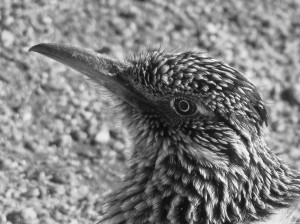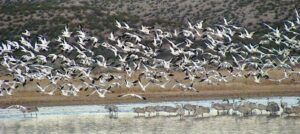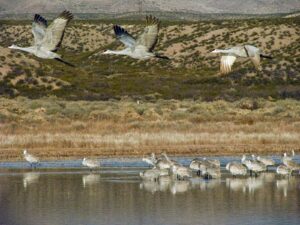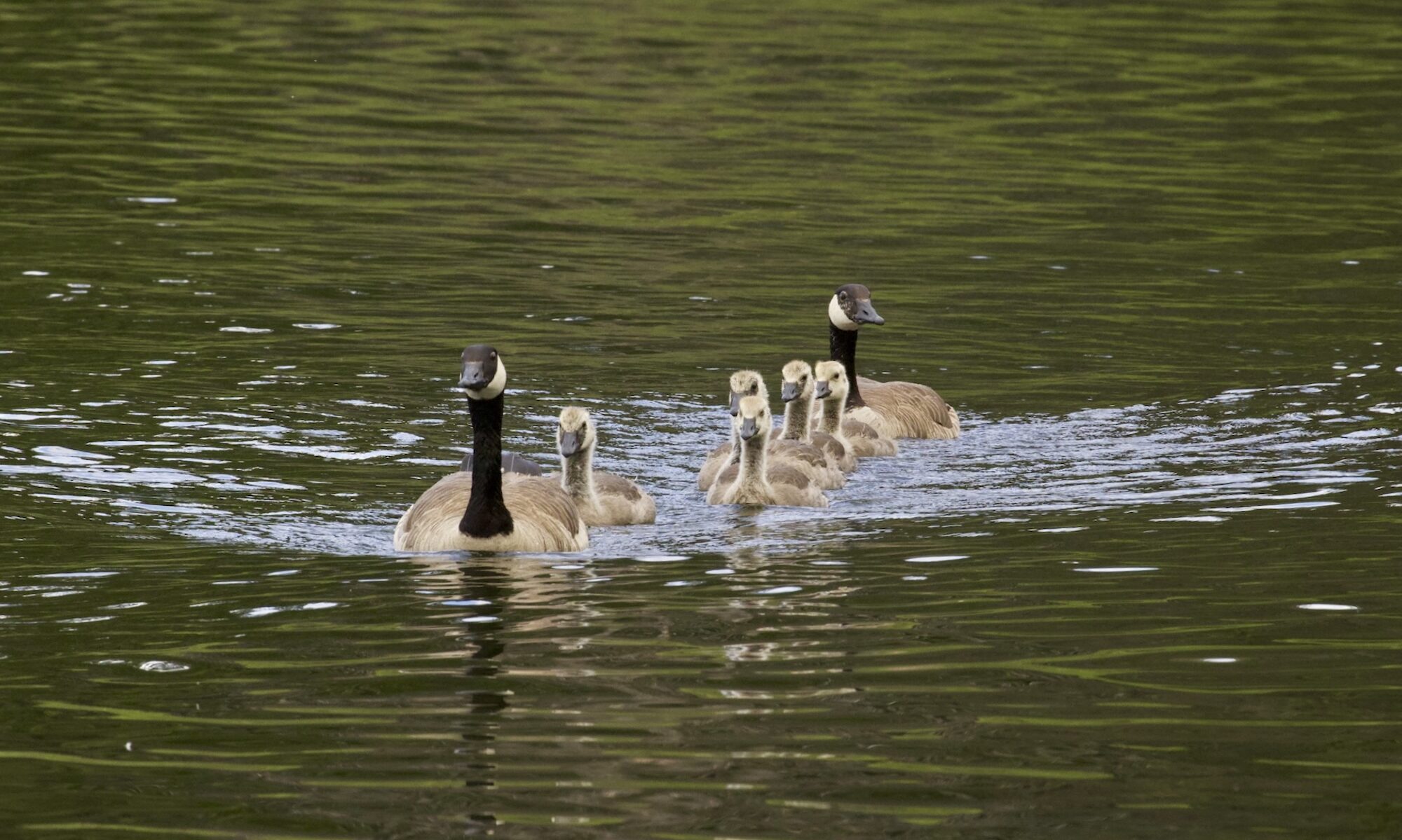
I was showered, shaved, and Shinola’d and had commandeered the bench outside the shower facilities at Arizona’s Catalina State park. The Santa Catalina mountain range monopolizes the eastern horizon of Tucson, and we were mesmerized spectators in the evening’s sunset. We rushed back to our site and photographed our camper framed by craggy formations that we would merely enjoy this evening but hope to explore more fully during a future visit.
The lovely daytime temperature of Tucson was a mild reprieve after leaving cold weather in Bosque del Apache, the winter fast-food flyover for sandhill cranes. At the recommendation of Ashland friends to experience the simultaneous lift-off of thousands of Snow Geese overnighting at the refuge, we dutifully awakened at 5:30 a.m. in order to be at the pond where we’d seen the geese and a substantial number of cranes land the evening before. They overnight in shallow water for protection from coyotes and other predators, and then fly (often hundreds of miles) to forage in fallow fields, picking through remnants to bulk up for their long journey to breeding grounds up north. It was still dark and bitterly cold when we arrived at the pond but heard the geese chatting with each other so we knew we were in the right place.

An hour later the rest of the spectators and photographers arrived but low clouds on the eastern horizon interfering with the signal to begin—sunrise. Shortly after the first rays appeared, and almost as if they were all tuned into the same broadcast, the geese suddenly rose from the pond and flew directly over our heads. An experienced photographer advised us to stand up-wind from the pond as the geese, like airplanes, take off into a headwind. We were also appreciative to have the chilly December wind at our back. In addition, we had been warned to wear head gear to protect us from more than the cold. In a moment they were airborne, leaving the sleepy cranes behind, and the geese grouped into formations in search of sustaining food.

The remaining cranes eventually took the cue, and slowly began extracting their heads and long necks from the protective warmth of a downy wing-pit. Our camera was poised for the much larger cranes to perform the same exciting lift-off but it wasn’t to be. They simply began taking off in what are described as family groups; 2-at-a time, then a group of 5, followed by a singleton. No apparent order, but the overnight community on the pond was rapidly diminishing for their daily flight south to better feeding grounds, so we decided to join them. We drove a couple hours south to Percha Dam State Park, just outside Hatch, NM, the principal source of those garlands of hundreds of dried red chiles all braided together. While interesting to see, we opted for the ounce or two of dried red chile flakes available at our food coop. But where there’re chiles, there’s salsa, and the take on Hatch chile is that it’s very, very hot.
We sampled New Mexico salsa on a delicious plate of juevos rancheros, smothered with green chile verde and, as predicted, quite spicy. It was delicious, and I bought a pint after a breakfast and nipped at it as one would a fine tequila. This chile salsa simply shamed the competition and complemented practically everything for the next couple of days. The texture of the salsa was uncharacteristically thick, almost glutinous, and Sooney speculated it may be prepared with chicken feet that would add a thickening agent to the mix. While we hope that’s the special additive, I fear it may be lard added and am thankful I limited myself to a pint. We hope to lean how to make this salsa, however, because once sampled, one should not live without it. Like a ripe avocado or a soft, juicy Medjool date—how can you NOT have these as staples of your diet?
After a lazy day of birding, reading, and exploring the region on foot, we realized the significance of Percha Dam State Recreation Area—it’s on the flight plan of the Sandhill Cranes in their search of food. Little did we know that while we were driving south, the Cranes were doing the same, only farther. As dusk approached, we first heard—and then saw—thousands of cranes returning to the security of the wildlife refuge after foraging fields south of us. They sometimes fly in a “V” formation (but not always) and honk at each other as would hikers yak on a trail. Their range is 300 miles and they fly at about 30 mph, so you can imagine our surprise to see formation after formation after formation flying above us, honking away. Even more interesting, the following morning we were awakened by the same family groups heading south for more food.
After a delicious breakfast at the Array Cafe we learned from a local farmer how annoying the cranes can be, especially if you’ve just planted a crop of something they’re particularly fond of. The cranes scrape the soil, eat the seedlings, and move on. Farmers then absorb the cost of replanting with an attitude similar to our opinion of Ashland’s infuriating deer population. We jokingly quoted Sooney’s mother, Myrle, who allegedly once said, “I hate nature,” but the farmer didn’t get it. As long as they continue flying over his fields, I supposed he considers himself lucky. And maybe there’s something about hot chile seeds interfering with long-distance flights.
The following day was a travel day, and we easily made it to Tucson’s Catalina State Park in time for a lovely shower and sunset. A couple days later found me sitting on that same bench, admiring the canyons painted in the warm light of a setting sun. Only this time it was Christmas eve, and there was the camp host’s family depositing a HUGE box of wrapping paper into the dumpster following an obvious gift exchange. Ho-Ho-Hum. This will be Sooney’s and my first Christmas on the road and, with Alicia and Julie abroad and plans to visit the Amundson boys after the new year, we were newbies to a pseudo nomadic experience that rather effectively transcended consumer holiday culture. The exception was the massive waste of wrapping paper (burning wasn’t permitted in the state park), and we celebrated modestly among other RV’ers, of which more than a few were festooned with colored seasonal lights on their awnings.
